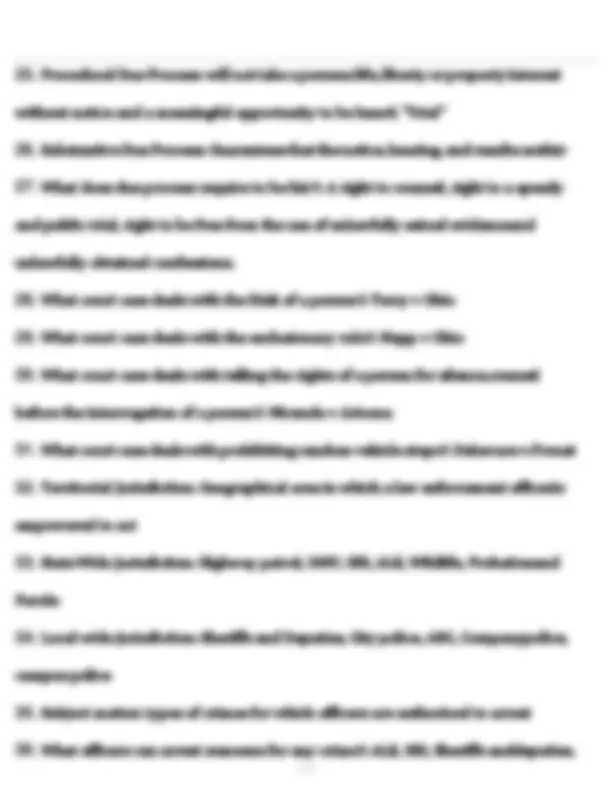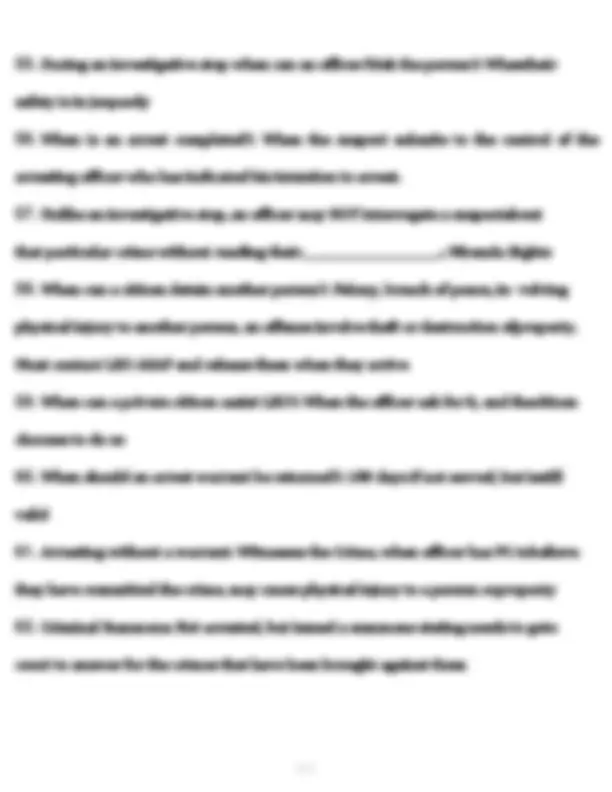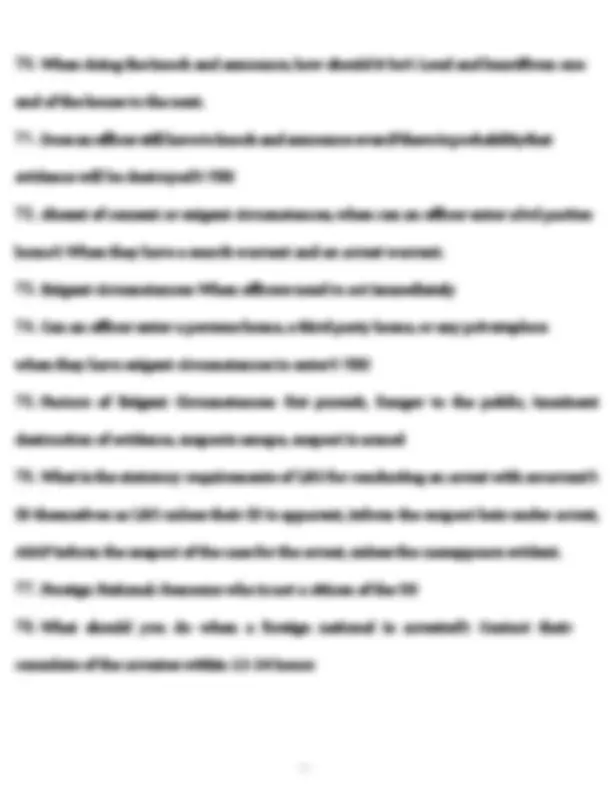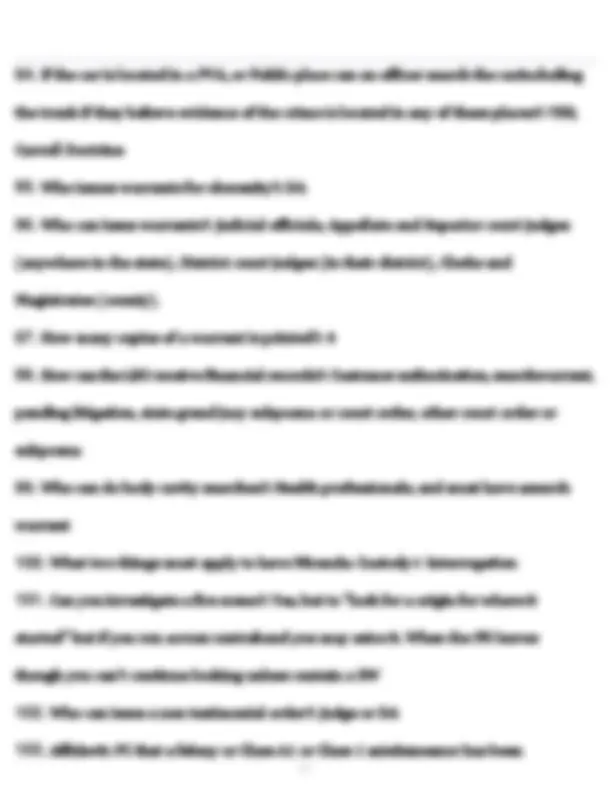










Study with the several resources on Docsity

Earn points by helping other students or get them with a premium plan


Prepare for your exams
Study with the several resources on Docsity

Earn points to download
Earn points by helping other students or get them with a premium plan
Community
Ask the community for help and clear up your study doubts
Discover the best universities in your country according to Docsity users
Free resources
Download our free guides on studying techniques, anxiety management strategies, and thesis advice from Docsity tutors
A comprehensive overview of constitutional law principles relevant to the nc blet state exam. It presents key concepts, legal definitions, and court cases related to the fourth amendment, procedural due process, and the use of force by law enforcement officers. Numerous exercises and questions designed to test understanding of these legal principles, making it a valuable resource for students preparing for the exam.
Typology: Exams
1 / 14

This page cannot be seen from the preview
Don't miss anything!









1 / 6
1. What are the 3 sources of law?: Constitutional, Statutory, Common 2. Common Law: Judge-made, Referred to as Case Law, brought over by England,a lot of common law has been codified in state statutes 3. Statutory Law: Written laws. Declares, commands, or prohibits something. Spe-cific. 4. Constitutional Law: Basic law of the land. Supreme law of the land. Protects the individual from the government. Only government officials can violate someones rights 5. What are the 2 types of law?: Substantive law, Procedural law 6. Substantive Law: Rights and duties of citizens. Created by legislative and judicialaction.
2 / 6
7. Procedural Law: Whereby substantive law is enforced. 8. Article VI: Supreme law of the land. Supremacy Clause. Contrary to the state,judges have to abide by the US Constitution. 9. Habeas corpus: "have the body" Filed by the prisoner, to the judge, to see the legality of the detention. 10. What are the 4 procedural safeguards for a person accused of a crime?: - Habeas Corpus, Jury, Bills of attainder, ex post facto laws 11. Jury: all criminal cases except impeachment be tried by a jury 12. Bill of attainder: special act of the legislature inflicting punishment on a person without a conviction through judicial proceedings. 13. Ex post Facto: Cannot go back and charge someone when a new law comesout for someone who did the crime before it became illegal.
4 / 6
21. Mapp v Ohio: Exclusionary Rule, Makes any illegally obtained evidence throughan illegal search or seizure inadmissible in court. 22. 5th Amendment: Double Jeopardy, Self- incrimination, Federal Due Process 23. 6th Amendment: Right to a speedy and public trial. Right to counsel. Attachesonce the charge has been filed. 24. 8th Amendment: Protects from excessive bail
5 / 6
25. Procedural Due Process: will not take a persons life, liberty or property interest without notice and a meaningful opportunity to be heard. "Trial" 26. Substantive Due Process: Guarantees that the notice, hearing, and results arefair 27. What does due process require to be fair?: A right to counsel, right to a speedy and public trial, right to be free from the use of unlawfully seized evidenceand unlawfully obtained confessions. 28. What court case deals with the frisk of a person?: Terry v Ohio 29. What court case deals with the exclusionary rule?: Mapp v Ohio 30. What court case deals with telling the rights of a person for silence,counsel before the interrogation of a person?: Miranda v Arizona 31. What court case deals with prohibiting random vehicle stops?: Delaware v.Proust 32. Territorial Jurisdiction: Geographical area in which a law enforcement officeris empowered to act 33. State Wide Jurisdiction: Highway patrol, DMV, SBI, ALE, Wildlife, Probationand Parole 34. Local wide Jurisdiction: Sheriffs and Deputies, City police, ABC, Companypolice, campus police 35. Subject matter: types of crimes for which officers are authorized to arrest 36. What officers can arrest someone for any crime?: ALE, SBI, Sheriffs anddeputies,
7 / 6
44. When is a person under arrest?: When their freedom of movement is takenaway or when they are told they are under arrest. 45. Reasonable Suspicion: More than a hunch, but less than PC 46. Probable Cause: having knowledge that a crime has been committed, enoughfor an arrest 47. What do you have to have to make an arrest?: PC 48. What do you need to detain an individual for an interview?: RS 49. Do officers need suspicion to go up to people in public and talk to them?- : No 50. When does a seizure occur?: Applies physical force, shows an amount of authority(commands them to stop, etc) 51. What is it when looking at all of the factors in a case rather than just one factor when determining whether or not a seizure what legally justified?: To- tality of the Circumstances 52. What is the purpose of an investigative stop?: To determine whether there is PC to believe that a crime has or is being committed, and the suspect has probablycommitted the crime. 53. What is the reasonable standard for an investigative stop?: ReasonableSuspicion 54. How long should a investigative stop last?: Reasonably, but approximately20 mins
8 / 6
55. During an investigative stop when can an officer frisk the person?: Whentheir safety is in jeopardy 56. When is an arrest completed?: When the suspect submits to the control of the arresting officer who has indicated his intention to arrest. 57. Unlike an investigative stop, an officer may NOT interrogate a suspectabout that particular crime without reading their .: Miranda Rights 58. When can a citizen detain another person?: Felony, breach of peace, in- volving physical injury to another person, an offense involve theft or destruction ofproperty. Must contact LEO ASAP and release them when they arrive 59. When can a private citizen assist LEO?: When the officer ask for it, and thecitizen chooses to do so 60. When should an arrest warrant be returned?: 180 days if not served, but isstill valid 61. Arresting without a warrant: Witnesses the Crime, when officer has PC tobelieve they have committed the crime, may cause physical injury to a person orproperty 62. Criminal Summons: Not arrested, but issued a summons stating needs to goto court to answer for the crimes that have been brought against them
10 / 6
70. When doing the knock and announce, how should it be?: Loud and heardfrom one end of the house to the next. 71. Does an officer still have to knock and announce even if there is probabilitythat evidence will be destroyed?: YES 72. Absent of consent or exigent circumstances, when can an officer enter a3rd parties home?: When they have a search warrant and an arrest warrant. 73. Exigent circumstances: When officers need to act immediately 74. Can an officer enter a persons home, a third party home, or any privateplace when they have exigent circumstances to enter?: YES 75. Factors of Exigent Circumstances: Hot pursuit, Danger to the public, imminent destruction of evidence, suspects escape, suspect is armed 76. What is the statutory requirements of LEO for conducting an arrest with awarrant?: ID themselves as LEO unless their ID is apparent, inform the suspect he is under arrest, ASAP inform the suspect of the case for the arrest, unless the caseappears evident. 77. Foreign National: Someone who is not a citizen of the US 78. What should you do when a foreign national is arrested?: Contact their consulate of the arrestee within 12-24 hours
11 / 6
79. When do you use NON-Deadly force?: escaping custody, defend oneself andmake the arrest. Does not matter ab Race, Gender, Sex, Age. 80. All force must be ?: Objectively reasonable 81. When can an officer use deadly force?: Has to be imminent and in danger foroneself or third party, cannot create imminent threat. Has to be REASONABLE. 82. Does an officer have to retreat?: NO 83. What is deadly physical force?: Anything that can kill someone. EX: hands, hammer, bat 84. Which deadly force do LEOs do NOT use?: Escapee of the Prison, ONLYDOC 85. How long is a warrant valid?: All the time, just needs to be returned to magistrate if not served in 180 days, but still is in the system 86. Warrantless searches-- Can a person limit, revoke, or control how much LEO can search a person, premises or vehicles when they have given con-sent?: YES 87. Warrantless searches-- Search and Seizure based on plain view doctrine?- : Lawfully in a position and see the item. Anything that is illegl or something that theyarnt suppose to have I.E. Stolen items, Officers have have lawful right of access tothe object. 88. Does an officer need a warrant to seizure contraband from a car that is ina public place, that they see from the outside of the car?: NO
13 / 6
94. If the car is located in a PVA, or Public place can an officer search the carincluding the trunk if they believe evidence of the crime is located in any of these places?: YES, Carroll Doctrine 95. Who issues warrants for obscenity?: DA 96. Who can issue warrants?: Judicial officials, Appellate and Superior court judges (anywhere in the state), District court judges (in their district), Clerks and Magistrates (county). 97. How many copies of a warrant is printed?: 4 98. How can the LEO receive Financial records?: Customer authorization, searchwarrant, pending litigation, state grand jury subpoena or court order, other court order or subpoena 99. Who can do body cavity searches?: Health professionals, and must have asearch warrant 100. What two things must apply to have Miranda: Custody+ Interrogation 101. Can you investigate a fire scene?: Yes, but to "look for a origin for where it started" but if you run across contraband you may seize it. When the FD leaves though you can't continue looking unless contain a SW 102. Who can issue a non testimonial order?: Judge or DA 103. Affidavit: PC that a felony or Class A1 or Class 1 misdemeanor has been
14 / 6 committed
104. How long is a non testimonial order good for?: 72 hours 105. How is non-custoidial interview techniques be used to obtain lawful confessions?: The person feels as if they are not under arrest, you don't have to read them their rights, they are free to come and go as they please, the LEO statesmultiple times they are not under arrest 106. When interrogating someone how does the 5th amendment cover the suspect?: The police cannot force them to say anything. 5th amendment does notapply in civil court 107. When interrogating someone how does the 6th amendment cover the sus-pect?: The right to counsel attaches at the time of the "critical stage" (magistrate) 108. What does it mean when someone invokes their right to counsel?: Theysay they want their attorney. 109. Can LEO question someone that has not invoked their 6th amendmentright?: YES 110. Photographic ID-Photo Lineup: ID procedure utilizing photographs of the suspect, rather than having the suspect physically appear. Photos should be similarto the suspect